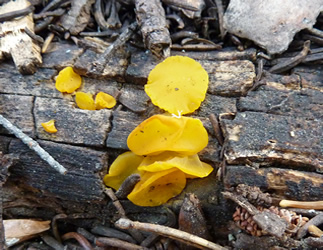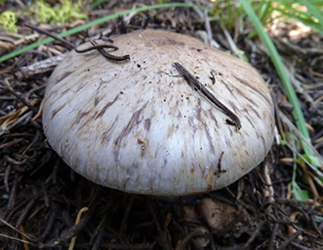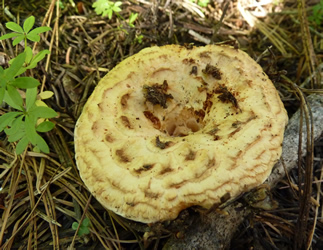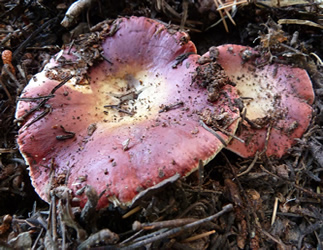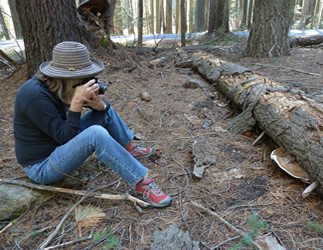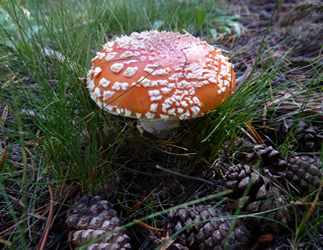Yosemite National Park Fungal Survey 2011
We made five trips to Yosemite National Park this year to support the fungal survey. A trip in June was only moderately productive. A trip in mid-September, following monsoon rains, was the best collecting. We were given accommodations with lab space in the kitchen at Bug Camp at Tuolumne Meadows. Doug Smith joined us on that trip, and he collected many, many small interesting fungi. What follows is a report of that effort, just before a big storm brought 12-18 inches of snow to Tuolumne Meadows. We made two additional trips in October.
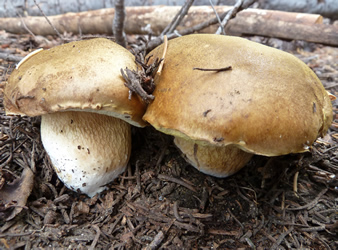 |
 |
Boletus edulis © photo by David Rust |
Amanita gemmata group © photo by David Rust |
Since the conditions were so good at Yosemite two weekends ago, coming off five days of rain, I thought I’d head back up to see what had developed. I also decided to jump in a two day window before a series of storms, with snow and sub-freezing temperatures coming right up, which would bring the end of the season at high elevation. I guess the timing was right: I brought home five partially filled shopping bags of mushrooms.
From the park entrance, I headed straight up to 10,000 feet where we had poked around on our previous trip. In mid September, rain had not produced many fungi in Dana Meadows, the Mono Pass trailhead, or the Tenaya Lake area. In 12 days time, not much had changed at that elevation. The ground was dry. A smattering of Suillus — some really beautiful — had popped up under Lodgepole pine. I found a few small surprises, like an Agaricus, still young with pinky gills near a dried up pond.
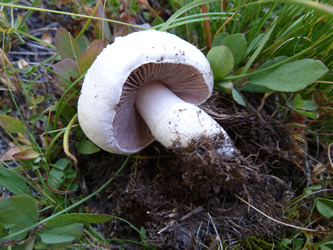 |
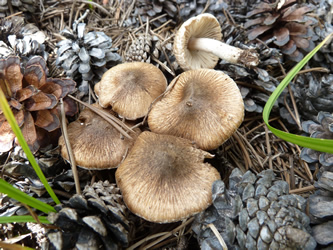 |
Agaricus species found near Dana Meadows |
Inocybe species found at 8,000 feet elevation |
At two pull outs near Lukens Lake and Yosemite Creek, conditions were good. I tried to hunt spots that looked wet and flat with large red fir and other conifers. Going from the wet side of the road to the dry also had its rewards. A purplish mushroom cap caught my eye with a pattern of fibrils: Cortinarius cyanites, an unusual find and the first for the Yosemite species list. I found a “nest” of four Amanita novinupta. Some hungry creature had eaten two of the caps; their stumps still protruding above the duff. The exposed stems led me to two emerging specimens in better shape. I also found two light colored disks under a huge red fir which turned out to be Boletus abieticola, one of the uncommonly collected butter boletes. Under Lodgepole pine up the road a bit, I found Boletus edulis and B. fibrillosus. In general, Amanitas were not in profusion – just a smattering of A. muscaria, A. gemmata group specimens. I was also surprised at the lack of small fungi, since we had seen so many only 10 days before. Yes, Inocybe were around in wet, mossy areas.
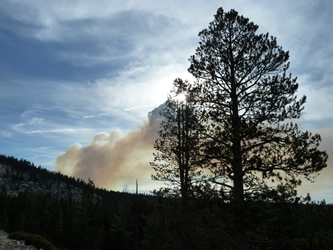 |
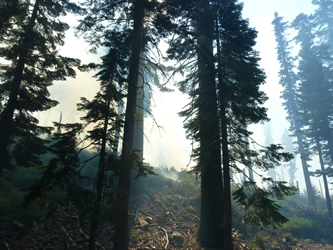 |
Smoke coming over a ridge from fire caused by lightning stike |
Burning brush and dead snags along Tioga Road |
There was a smoldering fire south of the road when I drove in. On my second day hunting, thick smoke East of Tamarack Flat drove me out. Driving back along Tioga Road, I found traffic cones, warning signs, firefighters, and billowing smoke. With a tree (dead snag standing) in full flames just 200 yards off the road, I knew it was time to leave the area. I could have been stranded on the wrong side of the fire with all my cooking equipment back at the campsite. I saw a coyote on the road to Tamarack Creek Campground, possibly driven out of the nearby fire zone.
 |
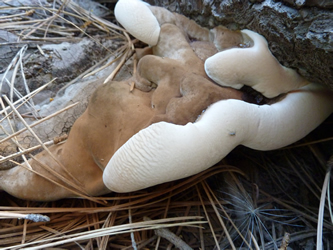 |
Fomitopsis pinicola |
Ganoderma applanatum |
In mid September, I was lucky enough to find three possible Gastroboletus species buried in the duff. One was so strange and gooey, like a dirty old sponge you hate to touch. I almost left it in its duff hole. When cut in half, it revealed a thick yellow columella in the middle, surrounded by a rich complex, spongy pack of contorted tubes. This specimen has piqued the curiosity of Dennis Desjardin at SFSU and Matt Trappe, author of "Field Guide to North American Truffles." Another gastroid bolete: Gastroboletus subalpinus, with a totally whitish-grey exterior, proved to be somewhat unusual as well.
On that trip, we heard a scary great story about a lightning hit on Highway 120, Tioga Pass Road. A thunderstorm blew through the Sierras early on the previous Tuesday evening. Hail was so intense people had to pull off the road. A lightning bolt hit a red fir at Porcupine Flat trailhead, bouncing to a metal trash can, bouncing to 14 cars in a long row. Blew out the airbags, blasted the electronics, even blew out tires. Two people were in a car, but were unhurt. Tow trucks were still hauling away cars on Friday. A cautionary tale, to be sure. Weather can be intense in the mountains and can change in a moment.
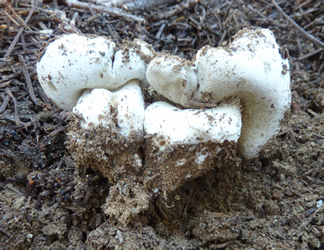 |
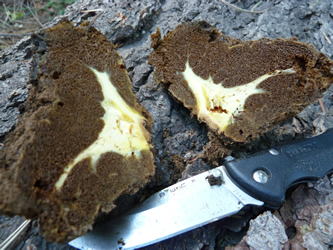 |
Gastroboletus subalpinus |
Gastroboletus species |
Near Crane Flat, Russulas had popped up in profusion, right beside clusters of Gomphus flocossus. There were many Cortinarius species, mostly buried under duff. On the other side of the road, I found a fleshy, pinky-beige ramaria, probably Ramaria botrytis. Coming out of the side of a log, Ischnoderma resinosum, still soft and spongy, like a dinner roll fresh out of the oven.
Gastroid species were not found this past weekend, but some other really odd fungi were. Examining each “mushrump” in the duff and crack in the ground, I dug out a scaly Sarcodon imbricatus, with white teeth under the cap. I found a tiny white mushroom growing out of a log which turned out to have pink gills, a Pluteus. Walking past a huge fallen Red Fir, I noticed two small boletes growing right out of the bottom from the sandy soil, identified in the Boletus chrysenteron group. I found this same species again in a different part of the forest, growing right out of the bottom of another fallen tree.
All in all, I collected about 45 notable species for the survey in two days’ hunting.
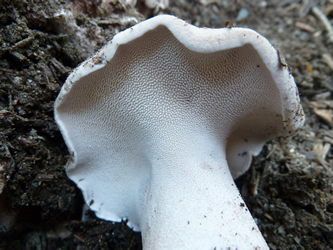 |
 |
Sarcadon imbricatus, underside with young spines |
Boletus abieticola, glowing like a beacon near the road |
Mushrooms on Halloween Weekend
Our friends on the park staff called in late October and told us they were seeing mushrooms everywhere, especially at elevation. We went up Halloween weekend and camped in Yosemite Valley. Bad news: Debbie found Amanita phalloides, the death cap, in a picnic area on the north side. Good news: lots of crazy cool species were out and about. We made some really interesting collections to contribute to the fungal survey!
 |
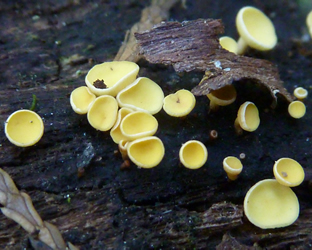 |
| Boletus fibrillosus, growing with Lodgepole Pine | Lachnellula agassizii, a stalked yellow ascomycete |

